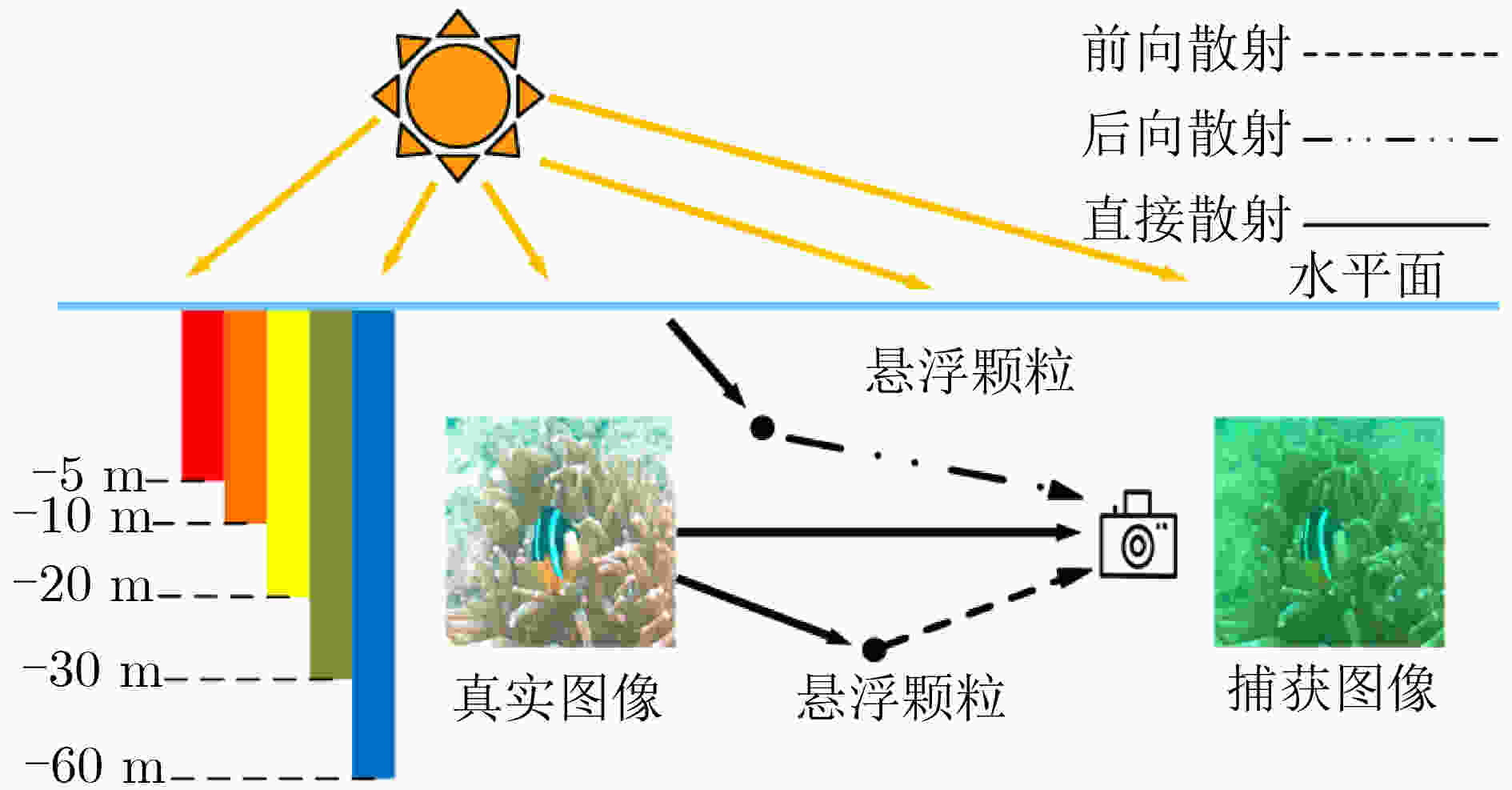Underwater Image Enhancement Algorithm Based on Blue-green Channel Color Compensation
-
摘要: 光在水中传播时受到水的吸收和悬浮粒子散射作用,导致水下图像颜色失真、对比度低、可视性差。针对上述退化问题,该文提出一种基于蓝绿通道自适应色彩补偿水下图像增强方法。首先,该方法分析水下成像模型的特点,根据蓝、绿色通道均值在3通道均值和的占比,将水下场景深度划分3个等级,利用光衰减率特性自适应补偿色彩,实现多场景色彩校正。然后对色彩补偿后的图像划分暗调、中间暗调、中间亮调、亮调4个区域,利用暗区域映射函数将图像暗区域映射到亮区域,在提升对比度的同时抑制噪声的产生。最后采用双线性插值解决分块处理产生的区域块效应。真实水下数据集实验结果表明,与现有方法相比,该方法可以提升多种场景的水下图像质量。Abstract: When light travels in water, it is absorbed by water and scattered by particles, resulting in color distortion, low quality, and poor visibility of underwater images. To solve this problem, an underwater image enhancement method is proposed based on blue-green channel color compensation. First, the characteristics of the underwater imaging model is analyzed, and the depth of the underwater scene is classified according to the proportion of the mean value of the blue and green channels in the sum of the mean value of the three channels, the light attenuation rate characteristic is used to adaptively compensate the color, and multi-scene color correction is realized. Then the color-compensated image is divided into four regions: dark tone, mid-dark tone, mid-bright tone, and bright tone. The dark region of the image is mapped to the bright region using the dark region mapping function, which improves the contrast while suppressing the generation of noise. Finally, bilinear interpolation is used to solve the regional effect of block processing. Experimental results on real underwater datasets show that compared with existing methods, this method can improve low-quality underwater images in a variety of scenes.
-
Key words:
- Underwater image /
- Underwater imaging model /
- Blue-green channel /
- Color compensation
-
表 1 水下场景深度等级划分
蓝绿通道均值占比 $ \forall ({W_{\text{G}}}{W_{\text{B}}}) \in [0,4.33) $ $ \exists ({W_{\text{G}}}{W_{\text{B}}}) \in [4.33,5.33) $ $ \exists ({W_{\text{G}}}{W_{\text{B}}}) \in [5.33,1] $ 场景深度 1级 2级 3级 表 2 100张水下图像不同方法处理结果的客观指标平均值(红色粗体:第1指标值;蓝色粗体:第2指标值)
UDCP RBE TSP IBLA GDCP RGHS GBDRC BRUIE 本文方法 AG 5.694 6.848 8.340 7.140 8.400 6.442 4.957 9.760 9.285 EI 55.258 70.088 80.506 69.066 81.176 62.475 48.026 92.678 89.624 PCQI 0.788 0.957 1.129 1.065 1.036 1.013 0.836 1.090 1.178 UCIQE 0.599 0.616 0.624 0.633 0.631 0.635 0.604 0.603 0.639 UIQM 1.732 1.412 1.507 1.472 1.517 1.502 1.525 1.528 1.586 -
[1] 郭银景, 吴琪, 苑娇娇, 等. 水下光学图像处理研究进展[J]. 电子与信息学报, 2021, 43(2): 426–435. doi: 10.11999/JEIT190803GUO Yinjing, WU Qi, YUAN Jiaojiao, et al. Research progress on underwater optical image processing[J]. Journal of Electronics &Information Technology, 2021, 43(2): 426–435. doi: 10.11999/JEIT190803 [2] ZHOU Jingchun, WANG Yanyun, ZHANG Weishi, et al. Underwater image restoration via feature priors to estimate background light and optimized transmission map[J]. Optics Express, 2021, 29(18): 28228–28245. doi: 10.1364/OE.432900 [3] HE Kaiming, SUN Jian, and TANG Xiaoou. Single image haze removal using dark channel prior[J]. IEEE Transactions on Pattern Analysis and Machine Intelligence, 2011, 33(12): 2341–2353. doi: 10.1109/TPAMI.2010.168 [4] ZHOU Jingchun, ZHANG Dehuan, and ZHANG Weishi. Classical and state-of-the-art approaches for underwater image defogging: A comprehensive survey[J]. Frontiers of Information Technology & Electronic Engineering, 2020, 21(12): 1745–1769. doi: 10.1631/FITEE.2000190 [5] GUO Yecai, LI Hanyu, and ZHUANG Peixian. Underwater image enhancement using a multiscale dense generative adversarial network[J]. IEEE Journal of Oceanic Engineering, 2020, 45(3): 862–870. doi: 10.1109/joe.2019.2911447 [6] 杨爱萍, 郑佳, 王建, 等. 基于颜色失真去除与暗通道先验的水下图像复原[J]. 电子与信息学报, 2015, 37(11): 2541–2547. doi: 10.11999/JEIT150483YANG Aiping, ZHENG Jia, WANG Jian, et al. Underwater image restoration based on color cast removal and dark channel prior[J]. Journal of Electronics &Information Technology, 2015, 37(11): 2541–2547. doi: 10.11999/JEIT150483 [7] 代成刚, 林明星, 王震, 等. 基于亮通道色彩补偿与融合的水下图像增强[J]. 光学学报, 2018, 38(11): 1110003. doi: 10.3788/AOS201838.1110003DAI Chenggang, LIN Mingxing, WANG Zhen, et al. Color compensation based on bright channel and fusion for underwater image enhancement[J]. Acta Optica Sinica, 2018, 38(11): 1110003. doi: 10.3788/AOS201838.1110003 [8] 杨爱萍, 张莉云, 曲畅, 等. 基于加权L1正则化的水下图像清晰化算法[J]. 电子与信息学报, 2017, 39(3): 626–633. doi: 10.11999/JEIT160481YANG Aiping, ZHANG Liyun, QU Chang, et al. Underwater images visibility improving algorithm with weighted L1 regularization[J]. Journal of Electronics &Information Technology, 2017, 39(3): 626–633. doi: 10.11999/JEIT160481 [9] SONG Huajun and WANG Rui. Underwater Image enhancement based on multi-scale fusion and global stretching of dual-model[J]. Mathematics, 2021, 9(6): 595. doi: 10.3390/math9060595 [10] WEN Haocheng, TIAN Yonghong, HUANG Tiejun, et al. Single underwater image enhancement with a new optical model[C]. 2013 IEEE International Symposium on Circuits and Systems (ISCAS), Beijing, China, 2013: 753–756. [11] LI Chongyi, GUO Chunle, REN Wenqi, et al. An underwater image enhancement benchmark dataset and beyond[J]. IEEE Transactions on Image Processing, 2019, 29: 4376–4389. doi: 10.1109/TIP.2019.2955241 [12] DREWS P JR, DO NASCIMENTO E, MORAES F, et al. Transmission estimation in underwater single images[C]. 2013 IEEE International Conference on Computer Vision Workshops, Sydney, NSW, Australia, 2013: 825–830. [13] FU Xueyang, ZHUANG Peixian, HUANG Yue, et al. A retinex-based enhancing approach for single underwater image[C]. 2014 IEEE International Conference on Image Processing, Paris, France, 2014: 4572–4576. [14] FU Xueyang, FAN Zhiwei, LING Mei, et al. Two-step approach for single underwater image enhancement[C]. 2017 International Symposium on Intelligent Signal Processing and Communication Systems, Xiamen, China, 2017: 789–794. [15] PENG Y T and COSMAN P C. Underwater image restoration based on image blurriness and light absorption[J]. IEEE Transactions on Image Processing, 2017, 26(4): 1579–1594. doi: 10.1109/TIP.2017.2663846 [16] PENG Y T, CAO Keming, and COSMAN P C. Generalization of the dark channel prior for single image restoration[J]. IEEE Transactions on Image Processing, 2018, 27(6): 2856–2868. doi: 10.1109/TIP.2018.2813092 [17] HUANG Dongmei, WANG Yan, SONG Wei, et al. Shallow-water image enhancement using relative global histogram stretching based on adaptive parameter acquisition[C]. 24th International Conference on Multimedia Modeling, Bangkok, Thailand, 2018: 453–465. [18] LI Chongyi, GUO Jichang, PANG Yanwei, et al. Single underwater image restoration by blue-green channels dehazing and red channel correction[C]. 2016 IEEE International Conference on Acoustics, Speech and Signal Processing, Shanghai, China, 2016: 1731–1735. [19] ZHUANG Peixian, LI Chongyi, and WU Jiamin. Bayesian retinex underwater image enhancement[J]. Engineering Applications of Artificial Intelligence, 2021, 101: 104171. doi: 10.1016/j.engappai.2021.104171 [20] YANG Miao and SOWMYA A. An underwater color image quality evaluation metric[J]. IEEE Transactions on Image Processing, 2015, 24(12): 6062–6071. doi: 10.1109/TIP.2015.2491020 [21] LEI Tao, JIA Xiaohong, ZHANG Yanning, et al. Superpixel-based fast fuzzy C-means clustering for color image segmentation[J]. IEEE Transactions on Fuzzy Systems, 2019, 27(9): 1753–1766. doi: 10.1109/TFUZZ.2018.2889018 -






 下载:
下载:









 下载:
下载:
